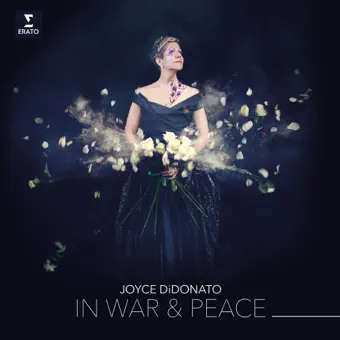november 2016
In War & Peace - Harmony through Music
Joyce DiDonato & Il Pomo d’Oro o.l.v. Maxim Emelyanychev
Zoals ons coverstory uitlegt, is Joyce DiDonato een zangeres die streeft naar het vinden van relevantie in muziek voor de wereld om ons heen. Deze ontroerende en dramatische cd is daar een perfect onderdeel van.

Yeats schreef in 1916 over ‘Kunst waarvan het einde vrede is’. Nu, 100 turbulente jaren later, keert mezzosopraan Joyce DiDonato terug naar de vraag hoe je troost en rust kunt vinden in een steeds meer wanordelijke wereld. Ook zij vindt haar antwoord in kunst – ‘een dapper pad naar vrede’, zoals ze schrijft in haar introductie van een album dat evenzeer een persoonlijk manifest is als een recital.
Terugkerend naar het repertoire waar het allemaal begon, vindt DiDonato met ‘In War & Peace’ voor het eerst in lange tijd weer barokgrond, en het is een vreugdevolle muzikale thuiskomst. De risico's zijn groter, de dramatische inzet hoger dan in 'Drama Queens' (1/13) - het is alsof zij en de muzikanten van Il Pomo d'Oro een uitgebreid spelletje kip spelen, waarbij ze elkaar uitdagen om een stillere, fragielere pianissimo te draaien, of om een da capo te versieren met een fellere schittering.
Door haar programma in twee helften te verdelen - 'Oorlog' en 'Vrede' - maakt DiDonato duidelijk dat dit geen rechttoe rechtaan binair systeem is. Vluchtige momenten van stilte en schoonheid zijn zelfs in oorlog te vinden ('Ze vertellen ons dat jullie machtige krachten hebben', 'Wanneer ik in de aarde word gelegd'), terwijl vrede extravert en vol vreugde kan zijn ('Da tempeste') of slechts een illusie, alleen gecreëerd om bedreigd te worden door ontvoering of verkrachting (Susanna's 'Kristallen stromen in gefluister stromen', prachtig gevormd, of 'Augelletti che cantate').
DiDonato laat opnieuw de flexibiliteit zien van een stem die zowel de onschuldige eenvoud van een Almirena als de volwassen emoties van Dido of Monteverdi's Penelope weet te vinden, terwijl ze vrijelijk tussen alt- en sopraanrollen beweegt. 'Illustratevi o cieli', de lang uitgestelde ontlading van de koningin in aria, straalt moeizaam verworven tevredenheid uit. Het beste zijn echter de meer demonstratieve aria's: Cleopatra's onstuitbare 'Da tempeste', Maxim Emelyanychev's band die hun begeleiding tokkelt als een gigantische gitaar; Leo's explosieve 'Prendi quel ferro', de beste van de drie prachtige aria's van Leo en Jommelli die hier hun première-opnames krijgen.
Drama, zoals altijd bij DiDonato, is alles. Ornamentatie dient eerst het verhaal, daarna het ego, tot bijna niets gereduceerd in ‘Lascia ch’io pianga’ uit angst om de oprechtheid van dit pleidooi voor vrijheid te overschaduwen, maar hoog opgevoerd in Jommelli’s ‘Par che di giubilo’. Een af en toe te hectisch vibrato is de enige smet op een overigens uitstekende opname

Writing in 1916, Yeats spoke of ‘Art whose end is peace’. Now, 100 turbulent years later, mezzo-soprano Joyce DiDonato returns to the question of how to find consolation and quiet in an increasingly disordered world. She too finds her answer in art – ‘a valiant path to peace’, as she writes in her introduction to an album that is as much a personal manifesto as a recital.
Returning to the repertoire where it all began, ‘In War & Peace’ finds DiDonato back on Baroque ground for the first time in a while, and it’s a joyful musical homecoming. The risks are bigger, the dramatic stakes higher than in ‘Drama Queens’ (1/13) – it’s as if she and the musicians of Il Pomo d’Oro are playing an elaborate game of chicken, each daring the other to spin a quieter, more fragile pianissimo, or to ornament a da capo with more ferocious brilliance.
Arranging her programme into two halves – ‘War’ and ‘Peace’ – DiDonato makes it clear that this is no straightforward binary. Fleeting moments of stillness and beauty are found even in war (‘They tell us that you mighty powers’, ‘When I am laid in earth’), while peace can be extrovert and full of joy (‘Da tempeste’) or merely an illusion, created only to be threatened by kidnap or rape (Susanna’s ‘Crystal streams in murmurs flowing’, exquisitely shaped, or ‘Augelletti che cantate’).
Roaming freely between alto and soprano roles, DiDonato once again demonstrates the flexibility of a voice capable of finding both the innocent simplicity of an Almirena and the mature emotions of Dido or Monteverdi’s Penelope – ‘Illustratevi o cieli’, the queen’s long-delayed release into aria, radiates hard-won contentment. Best, however, are the more demonstrative arias: Cleopatra’s irrepressible ‘Da tempeste’, Maxim Emelyanychev’s band strumming their accompaniment like a giant guitar; Leo’s explosive ‘Prendi quel ferro’, the pick of the three fine arias by Leo and Jommelli receiving their premiere recordings here.
Drama, as ever with DiDonato, is everything. Ornamentation serves narrative first, ego second, reduced to almost nothing in ‘Lascia ch’io pianga’ for fear of overbalancing the sincerity of this plea for freedom, but turned up high in Jommelli’s ‘Par che di giubilo’. An occasionally too-frenetic vibrato is the only blot on an otherwise excellent recording
